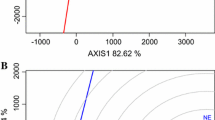Abstract
Genotype-environment (G × E) interaction plays a significant role in the relative expression of different cultivars in different environments. The productivity of chickpea in the Central and West Asia and North Africa (CWANA) region is constrained mainly by terminal drought because it is traditionally cultivated as a spring crop using conserved soil moisture. Studies conducted at the International Center for Agricultural Research in the Dry Areas (ICARDA) have clearly demonstrated that planting chickpea in winter can produce almost twice the yield of the spring crop. This study examined the extent and nature of G × E interaction on the yield of chickpea and identified genotypes that can produce high yields in both seasons. Sixteen sets of genotypes were evaluated in lattice designs at two contrasting locations in Syria and Lebanon in both spring and winter. In the analysis of individual trials, spatial variability was modeled in terms of block structure, linear trend across columns, and auto correlated plot errors. Genotype × season interaction was significant. The best linear unbiased predictor (BLUP) was obtained from individual analyses and adjusted across trials to screen from all the entries. Keeping in view the occurrence of high G × E interaction, and small number of genotypes in individual trials, selection efficiency was kept at a relatively moderate percentage (10%) to cover most of the desirable genotypes. The dual-season lines identified were FLIP98-121C, FLIP97-49C, FLIP97-50C, FLIP97-21C, S95082, FLIP97-17C, FLIP98-56C, and FLIP97-24C for Syria; and FLIP98-90C, FLIP99-37C, FLIP 97-56C, S96026, FLIP97-131C, FLIP 98-21C, FLIP01-63C, FLIP97-93C, and S95082 for Lebanon. We suggest that these genotypes be evaluated in multi-location trials with larger plots to identify the most desirable promising lines suitable for dual-season planting. The approach used in this study can be used to identify dual-season varieties in different target environments.


Similar content being viewed by others
References
Akaike H (1974) A new look at the statistical model identification. IEEE Trans Automat Control AC 19:716–723
DeLacy IH, Basford KE, Cooper M et al (1996a) Analysis of multi-environment trials-An historic perspective. In: Cooper M, Hammer GL (eds) Plant Adaptation and Crop Improvement. CAB International, Wallingford, UK, pp 39–124
DeLacy IH, Ratnasiri WGA, Mirzawan PDN (1996b) Retrospective analysis of historical data sets from multi-environment trials-Case studies. In: Cooper M, Hammer GL (eds) Plant Adaptation and Crop Improvement. CAB International, Wallingford, UK, pp 269–290
Kumar J, Singh KB, Malhotra RS et al (1996) Genotype x environment interaction for seed yield in chickpea. Indian J Genet Plant Breed 56:69–78
Malhotra RS, Sarker A, Saxena MC (2004a) Drought tolerance in chickpea and lentil—present status and future strategies. In: Challenges and strategies for dryland agriculture. CSSA Special Publication no.32. Crop Science Society of America and American Society of Agronomy, 677 S. Segoe, Rd. Madison, WI 53711, USA, pp 257–273
Malhotra RS, Singh KB (1991) Classification of chickpea growing environments to control genotype by environment interaction. Euphytica 58:5–12
Malhotra RS, Singh M, Erskine W (2004b) Application of Spatial Variability Models in Enhancing Precision and Efficiency of Selection in Chickpea Trials. J Indian Soc Agri Stat 57 (Special Volume), 2004:71–83
Payne RW (2000) The Guide to GenStat. Part 2: Statistics (Laws Agricultural Trust, Rothamsted Experimental Station)
Raghavarao D (1971) Constructions and combinatorial problems in design of experiments. New York, John Wiley
Singh KB, Malhotra RS, Saxena MC et al (1997) Superiority of winter sowing over traditional spring sowing of chickpea in the Mediterranean region. Agro J 89(1): 112–118
Singh M, Malhotra RS, Ceccarelli S et al (2003) Spatial variability models to improve dryland field trials. Exp Agri 39(2):151–160
Singh M, Yau SK, Hamblin J et al (1996) Inter-site transferability of crop varieties: Another approach for analysing multi-locational trials data. Euphytica 89:305–311
Acknowledgements
We thank Ms Suhaila Arslan for compiling the data for analyses, Drs Ashutosh Sarker, Osman Abdalla and two anonymous reviewers for their valuable suggestions for improving the article.
Author information
Authors and Affiliations
Corresponding author
Rights and permissions
About this article
Cite this article
Malhotra, R.S., Singh, M. & Erskine, W. Genotype × environment interaction and identification of dual-season cultivars in chickpea. Euphytica 158, 119–127 (2007). https://doi.org/10.1007/s10681-007-9436-0
Received:
Accepted:
Published:
Issue Date:
DOI: https://doi.org/10.1007/s10681-007-9436-0




